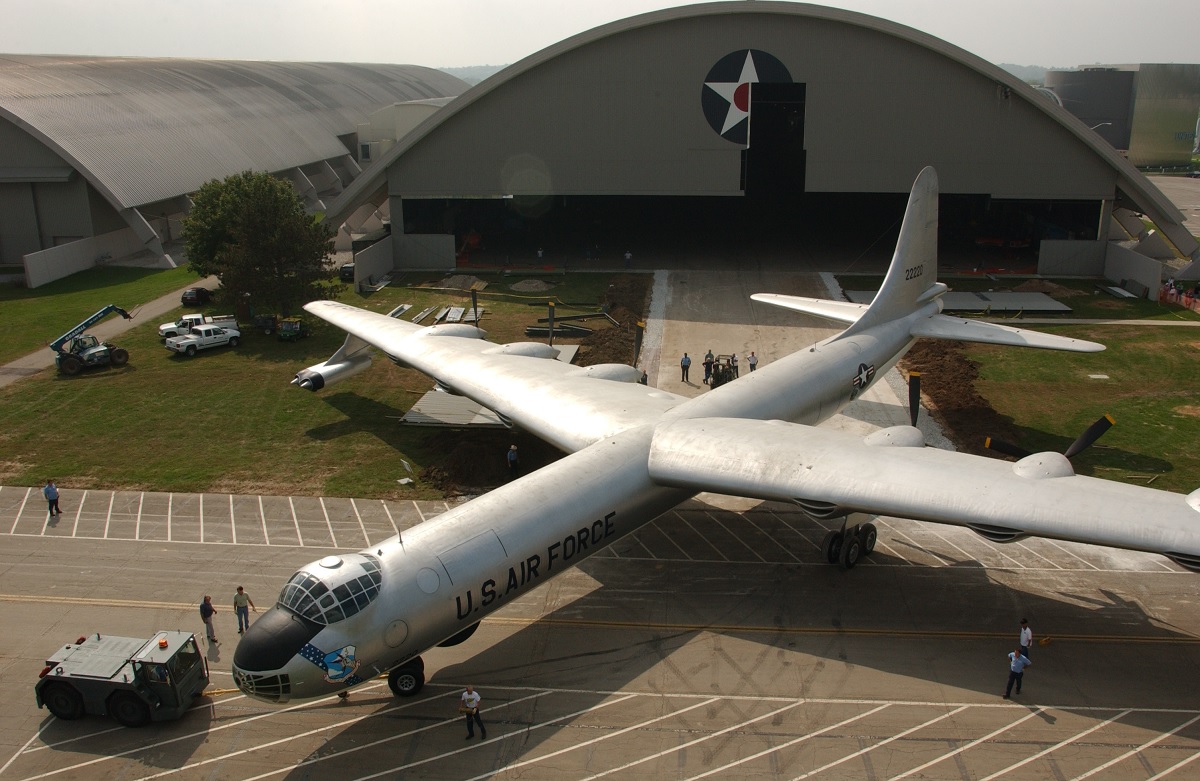‘During my three years at Ellsworth Air Force Ease I had two events that I call outstanding,’ A/1C Ralph Whitaker (Ret.), B-36 Electrical Gunner Upper
Responding to the US Army Air Forces’ requirement for a strategic bomber with an intercontinental range, Consolidated Vultee (later Convair) designed the B-36 during World War II. The airplane made its maiden flight in August 1946, and in June 1948 the Strategic Air Command received its first operational B-36. Some B-36s served as photographic reconnaissance aircraft, and others were adapted to launch and retrieve specially modified RF-84F/K reconnaissance planes.
Powered by six Pratt & Whitney R-4360 engines, the B-36J cruised at 230 mph, but for additional bursts of speed, its four General Electric J47s increased the maximum speed to 435 mph. It carried 86,000 pounds of nuclear or conventional bombs. When production ended in August 1954, more than 380 B-36s had been built for the US Air Force. In 1958-1959, the USAF replaced the B-36 with the all-jet B-52. Although never used in combat, the B-36 was a major deterrent to enemy aggression.
The RB-36 variants of the B-36 were used for reconnaissance during the Cold War with the Soviet Union and the B-36 bomber variants conducted training and test operations and stood ground and airborne alert, but the latter variants were never used offensively as bombers against hostile forces; it never fired a shot in combat.
A/1C Ralph Whitaker (Ret.) Electrical Gunner Upper AFT.RT. 717th Bomb Squadron (H), 28th Bomb Wing (H) Ellsworth Air Force Base Rapid City, South Dakota, recalls in Meyers K. Jacobsen’s book Convair B-36: A Comprehensive History of America’s “Big Stick”:
‘During my three years at Ellsworth Air Force Ease I had two events that I call outstanding.
‘My crew and I were involved in a “rum-run” to Ramey AFB around November 1954, and I’ve forgotten the name of the very capable aircraft commander. We took off loaded for Ramey AFB, when the left inboard flap stopped in about 15 degree down position. It looked loose and dangerous, so we pointed out the flap and gear indicators to the aircraft commander. The A/C sent the crew chief to the bomb bay to check the problem out, but to no avail. So the A/C invited any of the crew the option of bailing out. But with the option of fifteen mph ground winds for bailing out, or coming in with the plane still fully loaded with fuel, our A/C felt he had the confidence to give it a try. Besides, we had two miles of available runway. We all chose to ride it out, and proceeded to secure the area and buckled up tight in crash positions. The hot shot pilot touched the gears down on the very end of the runway and normally we’d slowed enough to turn off at the operations turn off. But today we went by operations engines in reverse and operations just a blur in the blister. We were slowing down, but we in the aft section couldn’t see the end of the runway rapidly coming at us. But we sensed somebody had better throw out the anchor. Fortunately, at the very end of the two mile runway, the pilot looped the plane around with the brakes squealing when it stopped. Finally, thereafter our ground crew fixed the broken flap linkage, and we proceeded to Ramey with no further problems.
‘The second event that really sticks with me was an airshow flight of our RB-36 to Billings, Montana, where a new airport celebration was in progress. This airport was built on a high bluff above the town and had an adequate runway of one mile for commercial aircraft and our RB-36. After setting overnight in the parking area, we found our main gear had sunk into the asphalt, about inches deep. Fortunately, we had enough power to pull out and proceed forward to the end of the runway, where we had to back up by reversing the props into a starting position for take-off. We took off with all ten engines roaring in about one-half of the one mile of available runway. We pointed the aircraft’s nose as straight up as possible, and at about 10,000 feet banked over in a “chandelle type” maneuver and came down aimed at the center of the runway. We then pulled out at about 100 feet above the runway and pulled up at the far end of the runway the same way. These maneuvers glued us to our seats until we leveled off and headed back for Ellsworth. The A/C had put on quite a show for everyone, including us.’
Convair B-36: A Comprehensive History of America’s “Big Stick” is published by Schiffer Publishing and is available to order here.

Photo by: U.S. Air Force and screenshot from YouTube video

